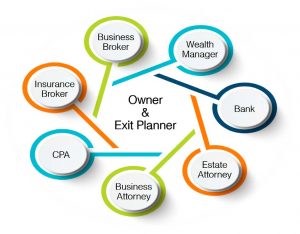
So why can’t you just sell your business in a couple of months?
Business owners are often told they need to get ready to sell their business, why can’t they just up and sell it? The short answer is that they are unlikely to sell it. Listing the business may be easy, getting someone to buy it, that’s the hard part. According to the Exit Planning Institute, only some 20-30% of businesses sell today.
You might be asking yourself, what actually makes a business part of this group who does sell?
Of course, there may be many answers to this question, but I think the biggest reason can be summed up in a single word: Risk. A business buyer is going to look at several factors when determining if they will buy. These factors lead them to conclude a risk level and they compare that with their tolerance for accepting risk. The higher the perceived risk, often there is a direct correlation with a lower multiple of EBITDA, and thus a lower selling price. In some cases, the risk perception may be so high that the buyer decides there is no price they would pay to accept that risk.
What are some of these perceived risks?
I think for a lot of small and lower middle market businesses, the challenges for a successful sale to an outside party are greater than for larger companies. Larger companies are larger because they sell more products – they need more inputs to sell a larger amount of their product. They need people, processes and management. Usually in a larger organization, the owner is not participating directly in the production or sales of the product, they have an organization that does this. Contrast this image with a smaller company where the owner is directly involved in the production of the product or sales – the greater this involvement, the greater the perceived reliance on the owner. We call this “owner centricity.” The higher the owner centricity, the riskier the proposition is to an outside buyer.
If the current owner is deeply active in production, sales or the management of the firm, then an outside buyer will have to replace those functions – they may conclude they will have to do these activities, and there is the rub. They may or may not want to do them, but perhaps more important, they may not perceive that they are able to do those functions. An owner who knows all his customers, an owner who is a gregarious personality and is responsible for attracting new business, an owner who has been at it for decades and knows the industry, the suppliers, the competition – those are all critical owner functions – the problem is that a new owner may not be able to see themselves doing those activities with the same success as someone who has done it for years. If the prospective buyer can’t see themselves as being able to do these functions as well, then they will question whether the business can repeat the sales and profits earned by the original owner. The degree to which this idea is challenged is risk.
A way to reduce this risk might be to reduce the level of owner centricity. To reduce the level of owner centricity, an owner would assess the critical functions of the business and measure the extent of their involvement. Once measured, the owner would undertake the process of implementing a management succession plan to develop written procedures, systems and policies, and begin the methodical process of handing over or delegating the owner’s responsibilities.
I like to think of a business as a mental model that fits inside of a shoebox. The box has systems, policies and procedures, that runs itself. It produces a repeatable process of making money. Imagine that one could reach inside that box and pulls the owner out! Now the owner owns the box that produces the repeatable product and earns a predictable profit. I recently met with a business owner client who shared that he had taken our advice and told his staff that he is no longer coming into the office. (His words were “only call me if someone dies”!) What he found was that the business ran without him, it produced recurring and repeatable revenue and profit streams. A new buyer might perceive that they can own that box, and they may then perceive it as less risky.
Exit, succession and continuity planning is about this process. Reducing owner centricity is one thing an owner can do to prepare for a sale or exit. This is not a quick fix, this takes time. Those who develop and implement an exit and succession plan over time may be able to reduce the perceived risks to a new buyer. You might say, those with a plan have a better chance of selling their business than those without a plan.
Mark Hegstrom is Certified Exit Planning Advisor and helps business owners to plan for what may be their single largest lifetime transaction: the transfer of their business. Get started by completing an exit readiness Assessment for yourself. Mark is Managing Partner at Business Owner Succession Strategies (BOSS). He currently serves as President of the Exit Planning Institute -Twin Cities Chapter.

 In my years of working with business owners, I’ve helped many transfer their businesses to family and employees. I’ve worked with others who sold their companies to a third party for tens of millions of dollars.
In my years of working with business owners, I’ve helped many transfer their businesses to family and employees. I’ve worked with others who sold their companies to a third party for tens of millions of dollars. If you are taking a long trip, you likely determine the route before you start out. If it is complex, you may print out the directions. Nonetheless, you are still likely to use a wayfinding app to alert you to problems along the way, like traffic jams or construction.
If you are taking a long trip, you likely determine the route before you start out. If it is complex, you may print out the directions. Nonetheless, you are still likely to use a wayfinding app to alert you to problems along the way, like traffic jams or construction. The exit planner may not be as skilled in any specific discipline as the others on the team. He may know something about tax planning, or legal structuring or insurance. She probably knows a bit about valuation and even more about contracts.
The exit planner may not be as skilled in any specific discipline as the others on the team. He may know something about tax planning, or legal structuring or insurance. She probably knows a bit about valuation and even more about contracts. At one end of the spectrum we’ll say you want to exit the business in the next thirty to sixty days. That’s probably enough time to draw up a purchase agreement and transfer ownership. The payment for the business would be entirely in an installment note from your workers. Rapid exit, but maximum probability that you will never see the entire purchase price.
At one end of the spectrum we’ll say you want to exit the business in the next thirty to sixty days. That’s probably enough time to draw up a purchase agreement and transfer ownership. The payment for the business would be entirely in an installment note from your workers. Rapid exit, but maximum probability that you will never see the entire purchase price.